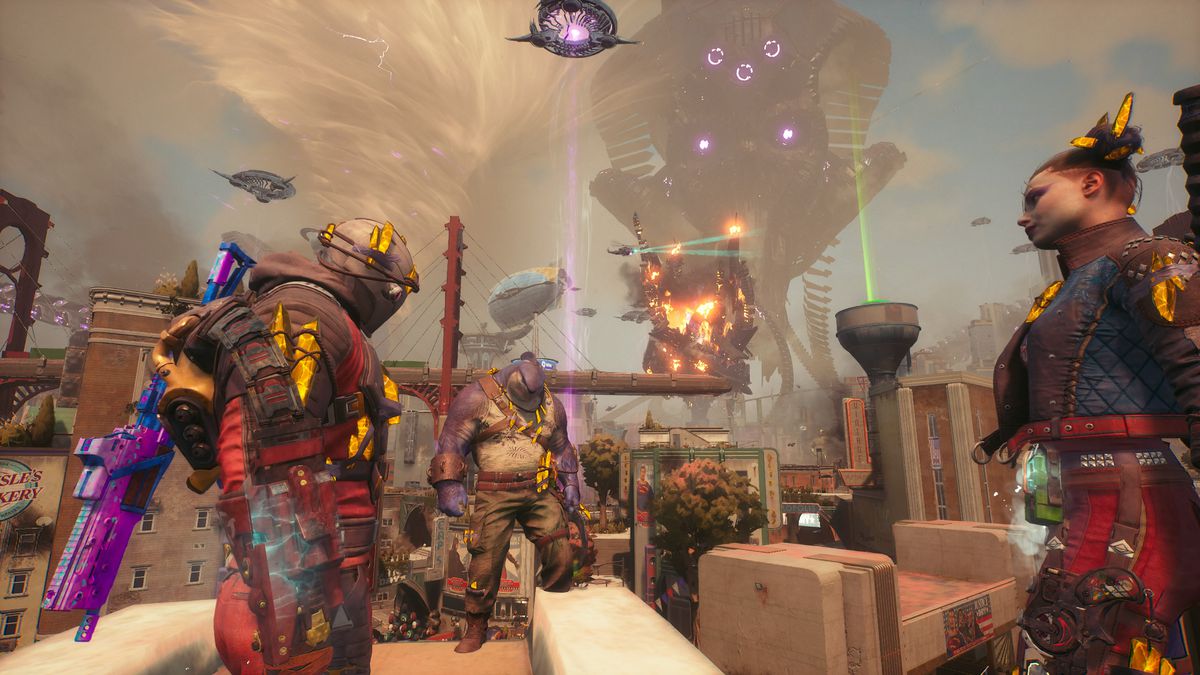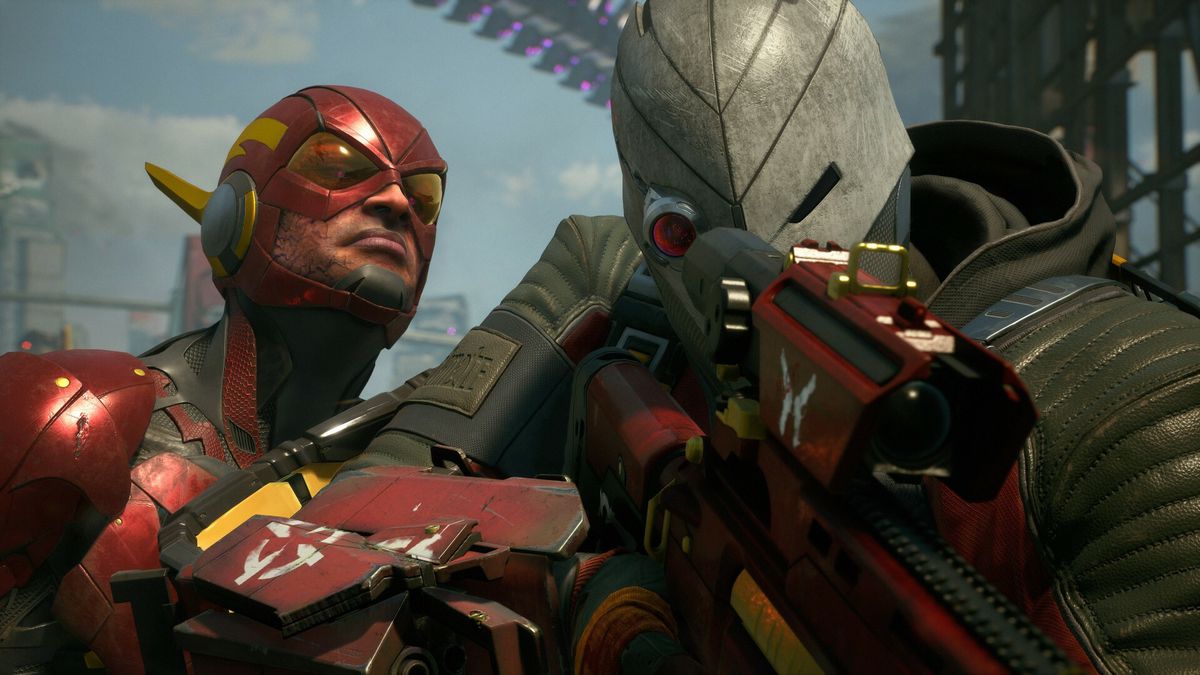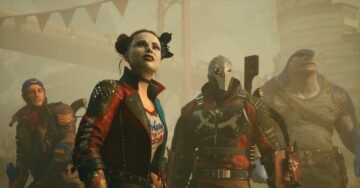The developers of the beloved Batman Arkham games have a new DC game, this time told from the villains’ perspective. But what should feel like a fresh start for Rocksteady Studios instead feels like a misstep — a game full of tired mechanics and bad jokes.
Suicide Squad: Kill the Justice League is a third-person shooter that expands Rocksteady’s Batman Arkhamverse from Gotham City to Metropolis, home of Superman and the Justice League. Alien supervillain Brainiac has invaded Earth, mind-controlled most of the Justice League, and enslaved Metropolis’ citizens as part of his plan to build a new version of his home planet.
Faced with a team of superheroes turned supervillains, government agent Amanda Waller enlists a quartet of criminal misfits — Captain Boomerang, Deadshot, Harley Quinn, and King Shark — into Task Force X, an expendable team that’s forced to follow her orders, lest she detonate tiny bombs in their heads. This Suicide Squad will have to use unconventional methods to take down the League and its master.
Three regular human beings and one not-so-bright sharkman don’t seem like much of a match for the likes of Superman and Green Lantern, so Suicide Squad: Kill the Justice League outfits the crew with guns and deadly gadgets that imbue the members with borrowed superpowers. This concept is relatively easy to swallow, right up until you come face-to-face with the sometimes godlike members of the League.
You’re always playing as a team in Kill the Justice League, either with friends in online multiplayer or with a trio of bots. You can switch between the characters when you want, but the game will recommend switching between certain squad members at points, mostly to give you some variety and add a little extra narrative punch to encounters.

Suicide Squad: Kill the Justice League also has a strong emphasis on traversal mechanics. Each member of Task Force X has their own way of getting around, with varying levels of satisfaction with their movements. King Shark can leap tall buildings with a single bound, making him the simplest to control. Deadshot has a straightforward, beginner-friendly jetpack. Captain Boomerang swipes a Speed Force glove, letting him sprint at ground level and sort of teleport. (“Boomer,” as his squadmates refer to him, easily has the strangest means of traversal.) Harley can swing around Metropolis in a way that blends Batman’s flying and Spider-Man’s swinging, but it feels frustratingly more clumsy than combining those two great-feeling video game locomotion methods should.
Movement through Metropolis mostly feels good, which is fortunate because you’ll spend a good portion of the game scaling buildings and leaping across rooftops between missions. Shooting, your primary means of taking down enemies, feels good too, at a basic level.
However, Rocksteady piles on a huge list of abilities beyond just shooting guns, and they range from inessential to overcomplicated. You can melee bad guys to recharge your shield; counter-shoot enemies poised to attack you; powerslide to knock enemies over; and so on and so on. There’s a huge array of guns, grenades, melee weapons, and elemental modifiers for every kind of weapon, so battles become visually and mechanically chaotic as a result, with the screen overwhelmed with effects and damage numbers. Suicide Squad: Kill the Justice League piles on too many mechanics, with some unnecessary to actually win fights — that is, until the game forces you to use them. In some of Suicide Squad’s most frustrating missions, certain enemies will only take damage through critical hits, or after you’ve acquired a resource that depletes over time. These combat tweaks transform already repetitive missions into a slog with difficulty spikes that don’t feel additive, just annoying.
Most of the enemies you wind up fighting throughout the city are mutated Metropolitans and Braniac-controlled vehicles. None of them are particularly interesting to fight against; oftentimes you’re just looking for and unloading on a purple pimple head until something explodes.

When you do come face-to-face with members of the Justice League, things take a turn for the worse. Characters like Flash, Green Lantern, and Superman, shown in other moments to have godlike abilities, inexplicably toy with Task Force X in protracted, gimmick-laden battles. Boss battles are full of spectacle, but also tedious and frustrating — league members zip around the screen in ways that are difficult to track and clog arenas with environmental attacks that can make frame rates chug.
Both side missions and main narrative quests are also painfully repetitive. They involve standing by a truck and shooting stuff. Or walking alongside a moving truck and shooting stuff. Or standing by one of Poison Ivy’s plants and shooting stuff. Sometimes you’ll be asked to recover civilians or soldiers who are trapped behind enemy lines, and that involves frantically shooting stuff until the mission unceremoniously ends.
Suicide Squad: Kill the Justice League is kind of a “looter shooter,” so post-mission, you’ll get a handful of rewards, including new weapons from arms dealer Penguin, a variety of currencies and materials (which you can turn in for new weapons or weapon modifiers), and some XP. You’ll slowly upgrade a tree of skills and abilities that don’t seem to have a noticeable impact on your performance amid the storm of explosions and damage numbers flying across the screen.
You’ll also get randomized gear after completing a task. You can craft gear, too, using the sundry currencies you gather around Metropolis. Unfortunately, these weapons, shields, and other bits of tech rarely feel impactful. There are so many modifiers and stats to decipher that I wound up just looking at the green arrows pointing up (better!) and red arrows pointing down (worse?) to decide if I should equip something or not. Eventually, I started to understand some of the game’s extensive jargon, but it didn’t affect much of my behavior in battle or in choosing my gear.

While missions are mostly dull, there’s a pretty entertaining story at the heart of Kill the Justice League. The members of Task Force X are a bunch of lovable losers who are very much in over their heads, and they succeed despite their incompetence, infighting, and backstabbing. Waller, portrayed viciously by the great Debra Wilson, is a believably cruel taskmaster who threatens the team constantly, which feels tonally appropriate given that, if she doesn’t, everyone’s going to die anyway. And the possessed members of the Justice League come across like real assholes, their ids brought front and center by Brainiac’s mind manipulations.
Fans of Rocksteady’s Arkham games, specifically its version of Batman, may find the game’s cruelty and cynicism tough to stomach. The game’s title pays off — yes, you will kill the Justice League, often in ways that feel dismissive of people’s fondness for these iconic characters. Almost everything is treated like a joke and only a handful of the gags land. The rest — attempts at humor are unrelenting — are interminably unfunny. At one point, a member of Task Force X suggests killing a boss by inserting his shrunken body into Captain Boomerang’s rectum. After completing the game’s story, I’m happy to be done listening to these characters.
What may be most surprising about Suicide Squad: Kill the Justice League is how much love, attention, and years of work have been put into it. Yet, it’s such a mediocre experience. There are moments of great storytelling here, and strong performances to back it up. Metropolis is a great-looking city, full of brightness and charm that Rocksteady’s Gotham lacked. And characters, particularly their faces, look gorgeous. The expressive animation of characters like Harley Quinn and King Shark goes a long way toward making these characters feel believable, sometimes even likable.
But the repetitive mission design, dreadful humor, and bland loot mechanics drag down what should have been a fun inversion of the dark Batman Arkham games. Suicide Squad: Kill the Justice League feels like a second round of closure for Rocksteady in the DC universe — but instead of the satisfying and hopeful ending of Batman: Arkham Knight, it brings the story to a close with an ear-ringing bullet in the head.
Suicide Squad: Kill the Justice League was released on Feb. 2 on PlayStation 5, Windows PC, and Xbox Series X. The game was reviewed on PS5 using a pre-release download code provided by Warner Bros. Games. Vox Media has affiliate partnerships. These do not influence editorial content, though Vox Media may earn commissions for products purchased via affiliate links. You can find additional information about Polygon’s ethics policy here.
- SEO Powered Content & PR Distribution. Get Amplified Today.
- PlatoData.Network Vertical Generative Ai. Empower Yourself. Access Here.
- PlatoAiStream. Web3 Intelligence. Knowledge Amplified. Access Here.
- PlatoESG. Carbon, CleanTech, Energy, Environment, Solar, Waste Management. Access Here.
- PlatoHealth. Biotech and Clinical Trials Intelligence. Access Here.
- Source: https://www.polygon.com/reviews/24062018/suicide-squad-kill-the-justice-league-review-rocksteady
- :has
- :is
- :not
- $UP
- 2%
- 5
- a
- abilities
- About
- acquired
- across
- actually
- add
- additive
- affect
- Affiliate
- After
- against
- Agent
- alien
- almost
- alongside
- already
- also
- always
- Amid
- an
- and
- animation
- anyway
- appropriate
- ARE
- arenas
- arms
- around
- Array
- AS
- asked
- At
- attack
- Attacks
- Attempts
- attention
- back
- background
- Bad
- basic
- batman
- Battle
- battles
- BE
- because
- become
- been
- behavior
- behind
- beings
- beloved
- between
- Beyond
- bits
- bland
- blends
- body
- borrowed
- BOSS
- bots
- bound
- Brings
- brought
- build
- buildings
- Bunch
- but
- by
- CAN
- Center
- certain
- characters
- choosing
- Citizens
- City
- civilians
- Close
- closure
- code
- combat
- combining
- come
- commissions
- completing
- concept
- constantly
- content
- control
- craft
- crew
- Criminal
- critical
- currencies
- damage
- Dark
- dc
- DC Universe
- dealer
- decide
- Decipher
- Design
- Despite
- destroyed
- developers
- Die
- difficult
- Difficulty
- do
- Doesn’t
- done
- Dont
- down
- download
- each
- earn
- earth
- easily
- easy
- Editorial
- effects
- either
- emphasis
- ending
- ends
- enemies
- entertaining
- environmental
- equip
- equipped
- Ether (ETH)
- ethics
- Even
- eventually
- Every
- everyone’s
- everything
- expands
- experience
- Explodes
- explosions
- expressive
- extensive
- extra
- faces
- Feb
- feel
- feels
- fight
- fighting
- fights
- Find
- Flash
- flying
- follow
- For
- Force
- forced
- Forces
- fortunate
- FRAME
- fresh
- friends
- from
- front
- frustrating
- frustratingly
- full
- fun
- Gadgets
- game
- Games
- gather
- Gear
- get
- getting
- Give
- given
- Goes
- going
- good
- Government
- great
- Green
- Ground
- GUNS
- handful
- happy
- Have
- head
- heads
- Heart
- her
- here
- him
- his
- Hits
- Home
- hopeful
- How
- HTTPS
- huge
- human
- Humor
- i
- iconic
- ids
- if
- Impact
- impactful
- in
- In other
- Including
- incompetence
- influence
- information
- instead
- interesting
- into
- inversion
- involve
- involves
- IT
- ITS
- jargon
- jpg
- just
- Justice
- Kill
- killing
- Kind
- King
- Land
- League
- Leap
- letting
- Level
- levels
- like
- likes
- lines
- links
- List
- Listening
- little
- Loadout
- Long
- Look
- looking
- Losers
- love
- Main
- make
- Making
- manipulations
- many
- master
- Match
- materials
- May..
- means
- mechanics
- Media
- member
- Members
- Menu
- methods
- mind
- Mission
- missions
- Moments
- more
- most
- mostly
- movements
- moving
- much
- multiplayer
- my
- NARRATIVE
- New
- None
- noticeable
- numbers
- of
- off
- often
- oftentimes
- on
- ONE
- online
- only
- or
- orders
- Other
- over
- overwhelmed
- own
- part
- particularly
- partnerships
- pays
- PC
- peeks
- people’s
- performance
- performances
- perspective
- plan
- planet
- plants
- plato
- Plato Data Intelligence
- PlatoData
- playing
- playstation
- PlayStation 5
- Point
- points
- poised
- poison
- policy
- Polygon
- Polygon’s
- portion
- portrayed
- pretty
- primary
- Products
- provided
- PS5
- punch
- purchased
- put
- quests
- Randomized
- range
- rarely
- Rates
- RAY
- real
- Recharge
- recommend
- Recover
- Red
- refer
- regular
- relatively
- released
- repetitive
- resource
- REST
- result
- reviewed
- Rewards
- right
- round
- satisfaction
- scaling
- Screen
- Second
- seem
- Series
- SERIES X
- Shark
- she
- Shield
- shooter
- shooting
- should
- showing
- shown
- side
- simplest
- single
- skills
- Slowly
- So
- some
- something
- sometimes
- specifically
- speed
- spend
- spikes
- Sprint
- stand
- standing
- start
- started
- stats
- Storm
- Story
- storytelling
- straightforward
- strong
- studios
- stuff
- succeed
- such
- Suggests
- Suicide
- superheroes
- surprising
- Swing
- Switch
- Take
- taking
- Task
- task force
- team
- tech
- tedious
- than
- that
- The
- their
- Them
- There.
- These
- they
- things
- this
- those
- though?
- threatens
- Through
- throughout
- time
- tiny
- tired
- Title
- to
- told
- too
- tough
- toward
- toy
- track
- Transform
- trapped
- treated
- tree
- trio
- truck
- TURN
- Turned
- tweaks
- two
- unconventional
- understand
- unfortunately
- Universe
- unnecessary
- until
- upgrade
- use
- using
- variety
- varying
- Vehicles
- version
- very
- via
- Video
- video game
- visually
- VOX
- vox media
- walking
- want
- Warner
- Warner Bros
- was
- Way..
- ways
- Weapons
- webp
- What
- when
- which
- WHO
- will
- Wilson
- win
- wind
- windows
- with
- Work
- worse
- X
- xbox
- xbox series
- Xbox Series X
- xp
- years
- yes
- yet
- you
- Your
- zephyrnet
- Zip












